This post may contain affiliate links. If you click an affiliate link and make a purchase, I may earn a commission. Also, as an Amazon Associate, I earn from qualifying purchases.--
Are you worried that your bike would corrode or rust in the rain? Cycling is an outdoor hobby/task. So your bike IS going to encounter rain and muddy puddles enough to get Peppa Pig jumping with joy.
However, this puts off lots of cyclists for a number of reasons. One of which is the hassle associated with storing, cleaning, and maintaining it before and after its time in the rain.
There are times, however, when leaving your bike in the rain is the only option. You should get a breathable, waterproof bike cover where there is no covered bike stand, put a plastic bag over your saddle, and store your bike in a cool, dry place after you clean and use a wet lube on it.
In this article I will provide you with all the 9 things to watch out for; to protect your bike, make it last longer, and reduce the hassle. Let’s get started!
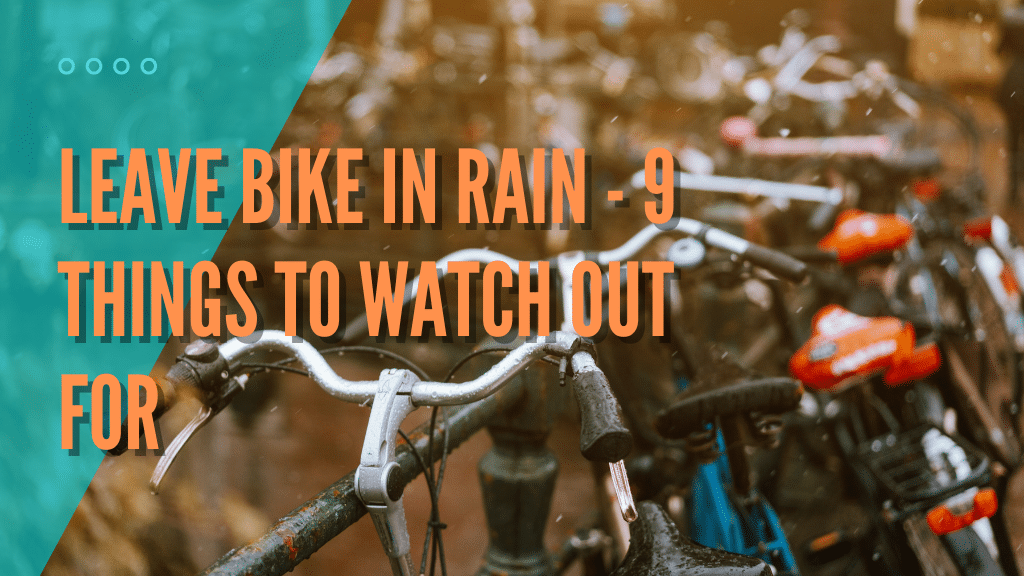
1. Leather Saddles Don’t Handle Rain Well
Leather saddles provide comfort and reduced friction for longer periods of time than other saddle materials. However, be aware that exposure to rain for long periods of time could tear and sag them. After water exposure, ensure to store your leather saddle in a dry place so that it can naturally dry out.
Ideally, you should also cover it with a plastic bag to protect it from rain. Although saddles made of synthetic material are not as comfortable, they have better water resistance (source). You could consider switching to one instead if you’ve had issues with your leather saddle due to rain exposure.
It is worth also mentioning here that saddle bags and panniers have varying levels of waterproofness. You should consider how long yours can withstand rain or splashes of water if you’re planning to leave it in the rain for some time. Although a waterproof one might be more expensive, it might be worth getting one anyway for your rides in the rainy season.
2. Keep Your Bike Lubricated
It may be convenient to leave your bike in the rain. However do note that your gears, derailleur, and bike chain could become clogged up with dirt and mud, blown onto it by rainy winds.
This can decrease the efficiency of your bike’s moving parts and degrade it over time. If you’re going to store your bike in the rain, then there is likely a greater need to undertake routine maintenance on your bike. Use a mild detergent, degreaser and a bike lubricant to thoroughly clean and keep your bike in tip-top condition.
How often should you do this routine maintenance?
Well, it depends on a variety of things, including the materials your bike is made from, how often it is kept in the rain, humidity, and so on. The answer also differs across cyclists.
Whenever you leave your bike in the rain, I suggest you at least clean and lube your drivetrain and chain, as they are more likely to attract dirt, debris, and mud.
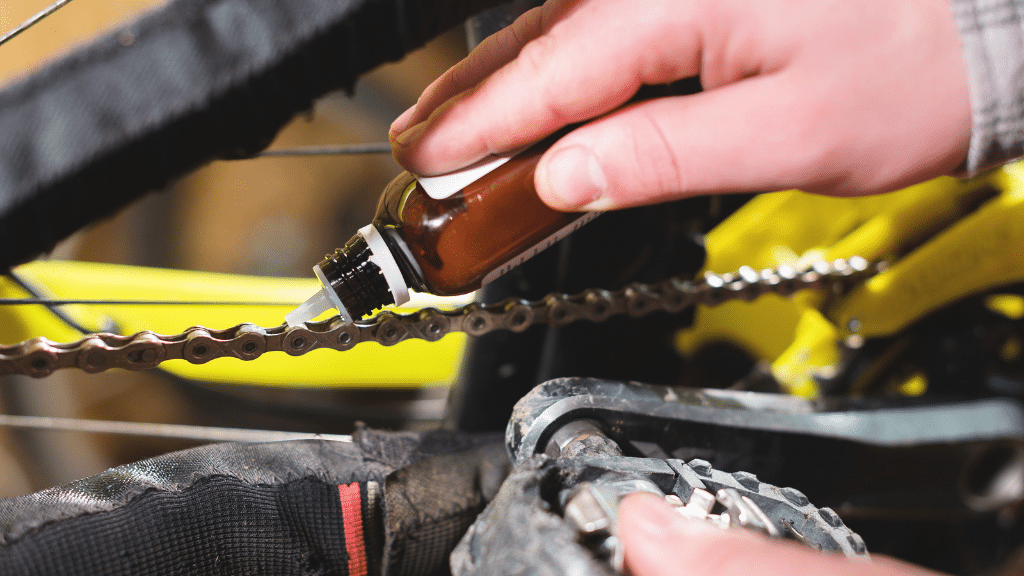
3. Dry Lube Isn’t Your Best Option
Dry lubricants are great for dry conditions, reduce friction and catch much less debris. However, they can be easily removed by water and puddles during the rainy season.
So what’s best to use in wet conditions?
Wet lubes are designed for all year conditions; particularly damp and rainy environments. They protect your bike parts better in such conditions (from corrosion, rust, etc) as they have a higher concentration of lubricant and viscosity (source). They are particularly more water resistant, so use these whenever you clean and lube your bike in the rainy season.
Don’t apply too much on your bike though. The higher amount of lubricant in it means that if applied excessively, it will attract lots of exactly what you are trying not to get onto your bike – dirt, and grime 😬!
4. Long Periods of Rain Exposure Increase Rust And Corrosion
Leaving your bike in the rain for a short period of time isn’t going to destroy your bike. Let’s say you haven’t washed your bike in a long time (not pointing any fingers..), your bike might thank you for the rain! Supposing of course that loads of dirt, mud, and debris aren’t flung onto your bike by puddle splashes.
However, a long period of rain exposure to your bike is expected to increase rust and corrosion on your bike; including the chainring, sprockets, and chain. This is due to higher moisture in the air and the slightly acidic nature of rain, which is known to increase corrosion (source).
Scouring through bike forums and discussing with my biking community, there indeed appears to be a consensus that long periods of rain exposure increase rust.
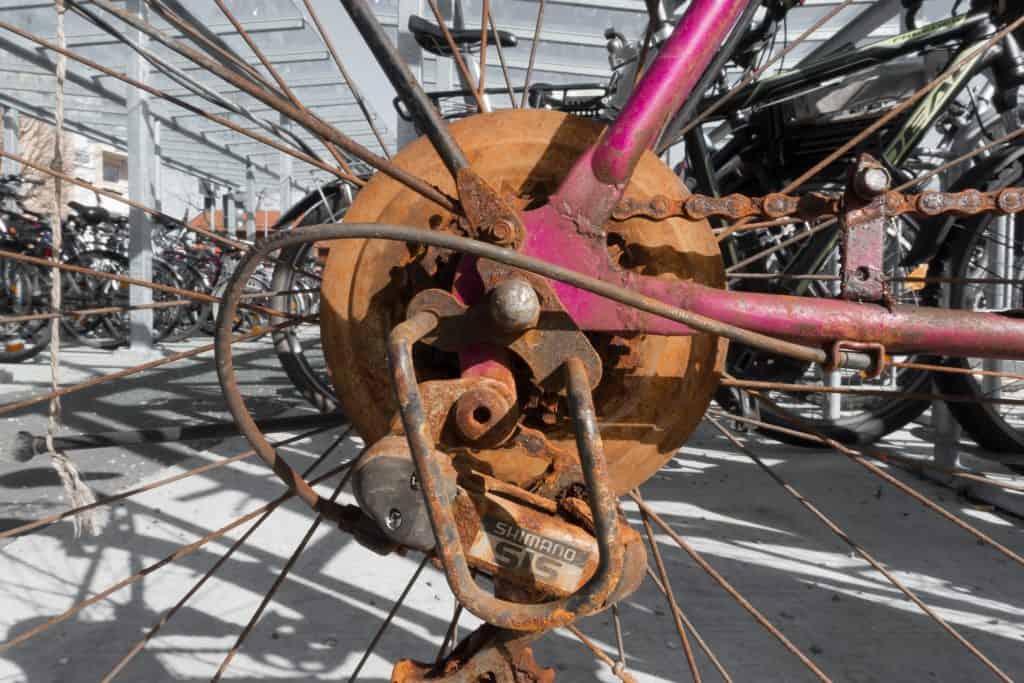
5. A Towel Is Your Best Friend
No, not to pat yourself dry! Unless you have also been left in the rain, by someone.
Leaving your bike in the rain is going to make parts of your bike slippery.
Riding with slippery handlebars, pedals, and a wet saddle can be unbearable, and unsafe. It causes a loss of grip while riding and not to mention, a soggy bottom. So unless you want to audition for who has the soggiest backside on the street, ensure to pat dry your saddle and other bike parts with a towel when you pick it up!
More importantly, the increased grip from patting your bike parts dry will ensure that you ride safely after you pick it up, with better control when riding in wet conditions.
6. Waterproof Bike Covers Are A Must
As previously mentioned, prolonged direct rain contact on your bike is likely to increase rust and corrosion.
One of my close friends recently decided to take up cycling to work to lose weight. His hopes of making it a daily commute were dampened when he found that there isn’t a covered bike stand near his workplace, to keep his bike from the rain.
Once he decided to get a waterproof bike cover, it gave him back the confidence he needed to take his bike to work in the rainy season. He now rides to work often, even in wet conditions.
Here are the benefits of using a waterproof bike cover:
- They are inexpensive and can prevent unwanted attention as they fully cover your bike.
- They should protect your bike from splashes of rain that are known to enter the nooks and crannies of the bike and cause it to corrode and rust.
- A good one should be made out of breathable material. This will permit air to circulate inside; preventing a damp-like environment where your bike is trapped in air filled with moisture.
So don’t let the lack of a covered bike stand throw a wrench in your plans to commute often in the rainy season. Use a waterproof bike cover instead.
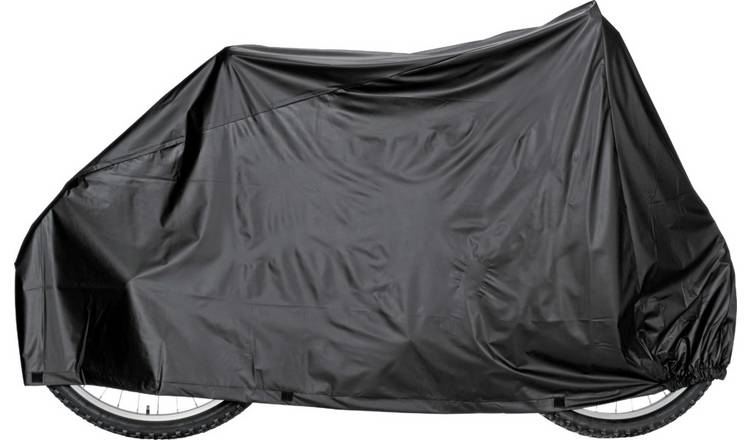
7. Store Your Bike In A Dry Place After Picking It Up
After you pick up your bike from the rain, you should store it in a cool, dry place. A key benefit of storing in a dry place is that it keeps your bike less exposed to the corrosion and rust that rainy water tends to attract; helping you to avoid crunchy bearings and rusted bolts.
Alternatively, the moisture in damp or wet places is not ideal for your bike due to the moisture in the air. This applies whether you’re storing your bike indoors or outdoors. If you have an electric bike, then ensure to keep your bike’s battery at less than 70°F, and not less than 30°F, as temperatures too high or too low could do irreversible damage to your battery (source).
Ideally, you want your bike to be completely dry in between rides. First, wash your bike, dry it, and re-lube it to get it ready for the ride.

8. Your Bike Lock Could Get Damaged
If you find your bike rusting due to long rain exposure, you might want to also check the condition of your bike lock, as it also may not be in the best condition. There’s nothing worse than coming back to your bike after a long period of rain and your key not being able to open it. This is likely due to dirt, debris, and rust trapped inside the lock.
Bike locks tend to be made out of metal. When they come into contact repeatedly with water the internal parts could rust or corrode, making it difficult for you to put in your key and unlock/lock it. Worse than that, the lock’s functionality could be completely impacted; making it easier to break into or unlocked by someone naughty.
When you lube your bike after it’s been exposed to rain, lube your bike lock also. First, clean out any gunk in the lock before applying lube to it. This way, you are setting up your lock to last and protect your bike for much longer.
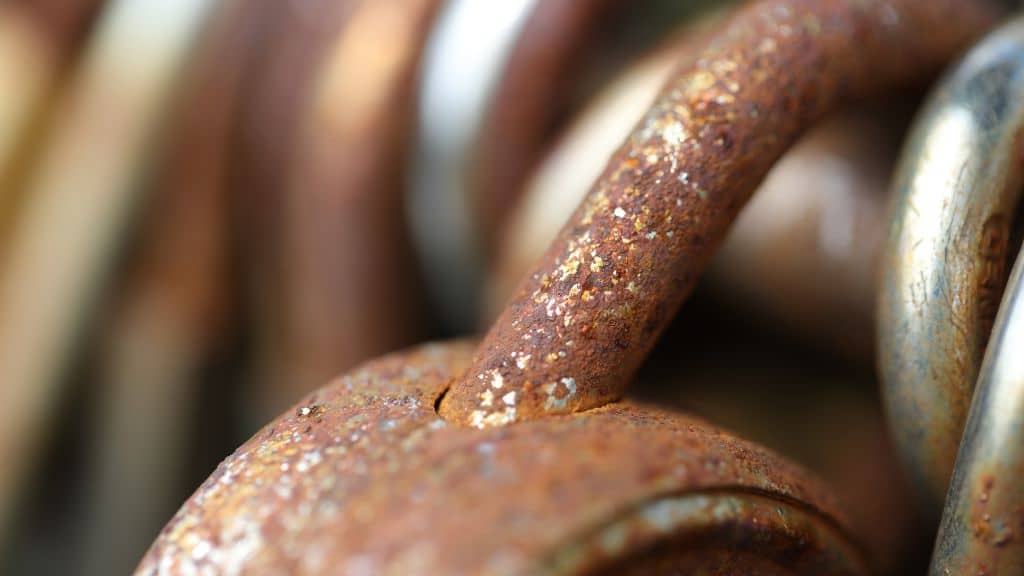
9. Watch Out For Damage To Electronics
It’s safe to say that electronics don’t always do well with contact with water. Luckily, it’s easy to tell which ones will or won’t.
An Ingress Protection (IP) code, tells you how well your electronic device (ie bike lights, e-bike battery, bike computer, etc) is protected against water and dust (source). If the IP code of your electronic device is 3 or 4 then you are protected against splashing water, liquids, moisture, and dirt.
This is ideal for when leaving your bike in the rain, as you can be assured that it will remain functional when you pick it up. So make sure to check the IP rating of your bike electronics before you make a purchase, particularly if you live in a climate with lots of rain.
Here’s an infographic with all the tips listed – ensure to share it with that friend who often leaves their bike exposed to rain:
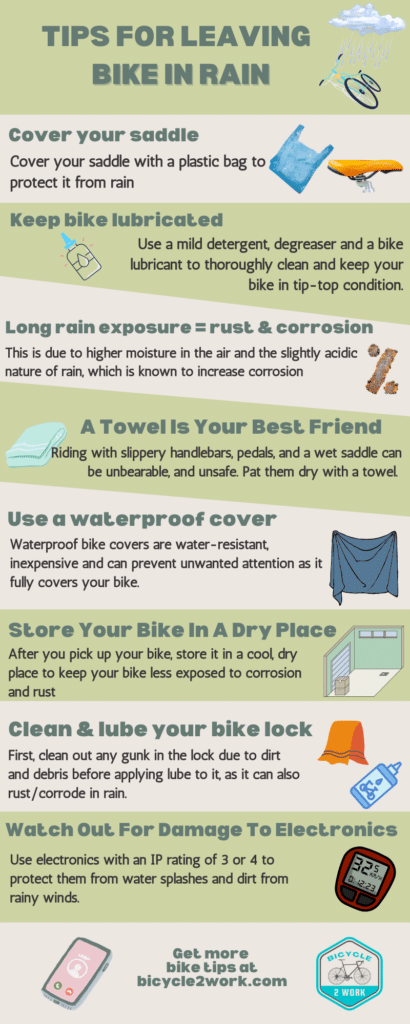
I also found this video to provide valuable tips for what to do after your ride in the rain:
Conclusion
So there you have it, 9 things I suggest you consider when leaving your bike in the rain next time.
In summary, metals rust and corrode after long periods of water exposure so be careful about how long you leave it in the rain.
A short period of rain is not likely to damage your bike. However, we suggest that you clean and use wet lube on your bike whenever you do so. Ensure to use a waterproof bike cover where there is no covered bike stand, use IP 3 or 4-rated electronic bike devices (as they are more water resistant), and store your bike in a dry place with temperatures not too high or cold.
Following these tips and the others mentioned in this article should significantly reduce the hassles associated with leaving your bike in the rain.
Frequently Asked Questions (FAQs)
How do you store a bike outside in the rain?
If there is no covered bike stand you should put a breathable, waterproof cover over your bike. This protects your bike from rain and dirt flung by rainy winds. If the cover is breathable, it allows air to circulate inside the cover; reducing the possibility of a damp-like, condensed environment inside it which contributes to rust and corrosion of your bike.
How do I protect my e-bike battery in the rain?
Most e-bike batteries have an IP rating of 5 or 6, and should therefore be protected from rain and dirt. However, you should ensure that it isn’t submerged in a puddle or pool of water or mud as this could damage it. A waterproof bike cover can protect both your bike and your battery in the rain.
What happens when you leave your bike out in the rain for a long time?
A long period of water exposure is expected to corrode and rust your bike. After a week, you should start seeing the effects of this appearing on your bike. If you have a leather saddle, it should also tear and sag after long periods in the rain.
We suggest that you clean and use wet lube whenever you leave your bike in the rain. Also, use a plastic bag to cover your saddle if you leave it in the rain.
